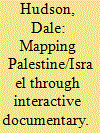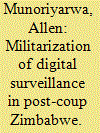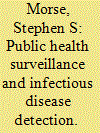|
|
|
Sort Order |
|
|
|
Items / Page
|
|
|
|
|
|
|
| Srl | Item |
| 1 |
ID:
142781


|
|
|
|
|
| Summary/Abstract |
Since 2001, border security policy between Canada and the US has morphed from “smart borders” to the present “beyond the border” (perimeter security) agreement resulting in the expansion of new techniques of border surveillance including pre-emptive profiling of travellers and biometric data sharing. In this paper, we argue that these border agreements have increasingly resulted in a changing experience of sovereign power for those crossing the border. This is demonstrated through a discussion of: the major border policies between Canada and the US since 11 September 2001, developed under the influence of US hegemony; how these policies perpetrate a generalised state of exception; and how these policies affect refugees, migrants, and citizens. Reading Agamben’s insights from a sociological perspective, we argue that the presumption of security-through-surveillance erodes border crossers’ human rights, and that some people – those from disadvantaged race/class backgrounds – are more affected than others by the implementation of the evolving border regime. We also emphasise the contingencies and unintended consequences of the ongoing projects. The conclusion offers brief comments on the consequences of these developments on Canadian identity and points out the directions for future research in this domain.
|
|
|
|
|
|
|
|
|
|
|
|
|
|
|
|
| 2 |
ID:
178332


|
|
|
|
|
| Summary/Abstract |
Available on publicly accessible websites, interactive documentaries are typically free to use, allowing audiences to navigate through amounts of information too large for standard film or television documentaries. Media literacy, however, is needed to understand the ways that interactive documentaries reveal or conceal their power to narrate. Examining ARTE France’s Gaza Sderot (2008–9), Zochrot’s iNakba (2014), and Dorit Naaman’s Jerusalem, We Are Here (2016), this article discusses documentaries that prompt audiences to reflect upon asymmetries in the power to forget history and the responsibility to remember it by mapping Palestinian geographies that have been rendered invisible. Since media ecologies are increasingly militarized, particularly in Palestine/Israel, interactive documentaries like iNakba and Jerusalem, We Are Here can disrupt Israeli state branding as technologically innovative while minimizing risk of surveillance by avoiding the use of location-aware technologies that transform interaction into tracking.
|
|
|
|
|
|
|
|
|
|
|
|
|
|
|
|
| 3 |
ID:
189031


|
|
|
|
|
| Summary/Abstract |
While a large body of research has documented and theorized digital surveillance practices in various political contexts, little has been done to investigate the growing trend of military-driven digital surveillance practices in semi-authoritarian regimes. In this article, I use the case of the surveillance practices of the Zimbabwe Defence Forces to argue that scholarship needs to (re)evaluate this emerging trend. The article has three aims: first, it explores military-driven surveillance capabilities, the circulation of such capabilities and the surveillance tactics emerging in the semi-authoritarian context of Zimbabwe. Second, it examines the interface of factionalism and politics within the Zimbabwe Defence Forces and how this influences quotidian military-driven digital surveillance practices. Third, it locates military-driven surveillance practices within a growing and complex global political economy of trade in surveillance technologies that is centred on China. In doing so, the article helps locate a largely neglected but increasing practice of military-driven surveillance that is incrementally reconfiguring surveillance practices and architectures in semi-authoritarian regimes. Such a form of surveillance provides gateways for human rights abuses and shrinks the civilian spaces of protest and engagement, leading to digital authoritarianism. The article therefore calls for greater scrutiny of the emerging practice of military-driven digital surveillance in semi-authoritarian political contexts.
|
|
|
|
|
|
|
|
|
|
|
|
|
|
|
|
| 4 |
ID:
126128


|
|
|
|
|
| Publication |
2012.
|
| Summary/Abstract |
Emerging infectious diseases, such as HIV/AIDS, SARS, and pandemic influenza, and the anthrax attacks of 2001, have demonstrated that we remain vulnerable to health threats caused by infectious diseases. The importance of strengthening global public health surveillance to provide early warning has been the primary recommendation of expert groups for at least the past 2 decades. However, despite improvements in the past decade, public health surveillance capabilities remain limited and fragmented, with uneven global coverage. Recent initiatives provide hope of addressing this issue, and new technological and conceptual advances could, for the first time, place capability for global surveillance within reach. Such advances include the revised International Health Regulations (IHR 2005) and the use of new data sources and methods to improve global coverage, sensitivity, and timeliness, which show promise for providing capabilities to extend and complement the existing infrastructure. One example is syndromic surveillance, using nontraditional and often automated data sources. Over the past 20 years, other initiatives, including ProMED-mail, GPHIN, and HealthMap, have demonstrated new mechanisms for acquiring surveillance data. In 2009 the U.S. Agency for International Development (USAID) began the Emerging Pandemic Threats (EPT) program, which includes the PREDICT project, to build global capacity for surveillance of novel infections that have pandemic potential (originating in wildlife and at the animal-human interface) and to develop a framework for risk assessment. Improved understanding of factors driving infectious disease emergence and new technological capabilities in modeling, diagnostics and pathogen identification, and communications, such as using the increasing global coverage of cellphones for public health surveillance, can further enhance global surveillance
|
|
|
|
|
|
|
|
|
|
|
|
|
|
|
|
| 5 |
ID:
190798


|
|
|
|
|
| Summary/Abstract |
Based on ethnographic research carried out during the 2022 Covid-19 surge in southern China, this paper examines the roll-out of a contact-tracing tool called the Time-Space Companion project. The project exemplifies a state effort to incorporate data-driven surveillance technology into the public health apparatus during the coronavirus outbreak. By exploring the definition, identification, and management of Time-Space Companions, the paper shows that the project was used to discipline Chinese citizens and shift public health responsibilities onto them by transforming daily life into sites of public health regulation, discipline, and criminalization. The project also exemplified an on-going state effort to leverage surveillance technologies for the purposes of social management. The paper draws attention to the social repercussions that resulted when technology offered a tempting tool to enhance the infrastructural and despotic powers of mundane state actors.
|
|
|
|
|
|
|
|
|
|
|
|
|
|
|
|
|
|
|
|
|